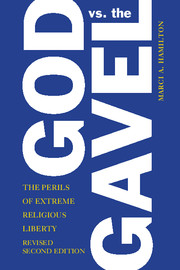Book contents
- Frontmatter
- Contents
- Acknowledgments
- Preface to the Second Edition
- Introduction: The Wages of RFRA
- Part One Religious Liberty is not a License to Harm Others
- 1 The Problem
- 2 Children
- 3 Marriage
- 4 Religious Land Use and Residential Neighborhoods
- 5 Schools
- 6 The Prisons and the Military
- 7 The Right to Discriminate
- Part Two The History and Doctrine Behind Common-Sense Religious Liberty
- Epilogue: Follow the Money
- Foreword to the 2005 Edition
- Notes
- Index
4 - Religious Land Use and Residential Neighborhoods
Published online by Cambridge University Press: 05 November 2014
- Frontmatter
- Contents
- Acknowledgments
- Preface to the Second Edition
- Introduction: The Wages of RFRA
- Part One Religious Liberty is not a License to Harm Others
- 1 The Problem
- 2 Children
- 3 Marriage
- 4 Religious Land Use and Residential Neighborhoods
- 5 Schools
- 6 The Prisons and the Military
- 7 The Right to Discriminate
- Part Two The History and Doctrine Behind Common-Sense Religious Liberty
- Epilogue: Follow the Money
- Foreword to the 2005 Edition
- Notes
- Index
Summary
Part One covers many arenas wherein religious entities act as though the public interest pales in comparison to their agendas. In many circumstances, though, the average American has little idea how religious entities are harming others. In contrast, the disputes in this Chapter occur in Americans’ own backyards.
Religious landowner impose intense challenges on local governments. They need worship space large enough to accommodate weekly (or bi-weekly) gatherings of a significant percentage of their members, and even bigger assemblies for holiday; they can also host schools, weddings, bar and bat mitzvahs, funerals, youth activities, and social services like Alcoholics Anonymous, blood drives, food kitches, and homeless shelters. Thus, a small building with minimal parking is ordinarily inadequate. In the era when these buildings were only used for worship and maybe a choir practice, despite their size, houses of worship were attractive residential neighbors. Church properties were like miniature parks of peaceful tranquility in residential neighborhoods – the grounds were pretty, the building was tasteful, and they were excellent neighbors. Parking, traffic, lights, and noise were not typical problems. That is no longer true as large religious projects are using extreme religious liberty arguments to wedge themselves into residential zones, and changing the character of the residential neighborhood.
- Type
- Chapter
- Information
- God vs. the GavelThe Perils of Extreme Religious Liberty, pp. 115 - 150Publisher: Cambridge University PressPrint publication year: 2014



